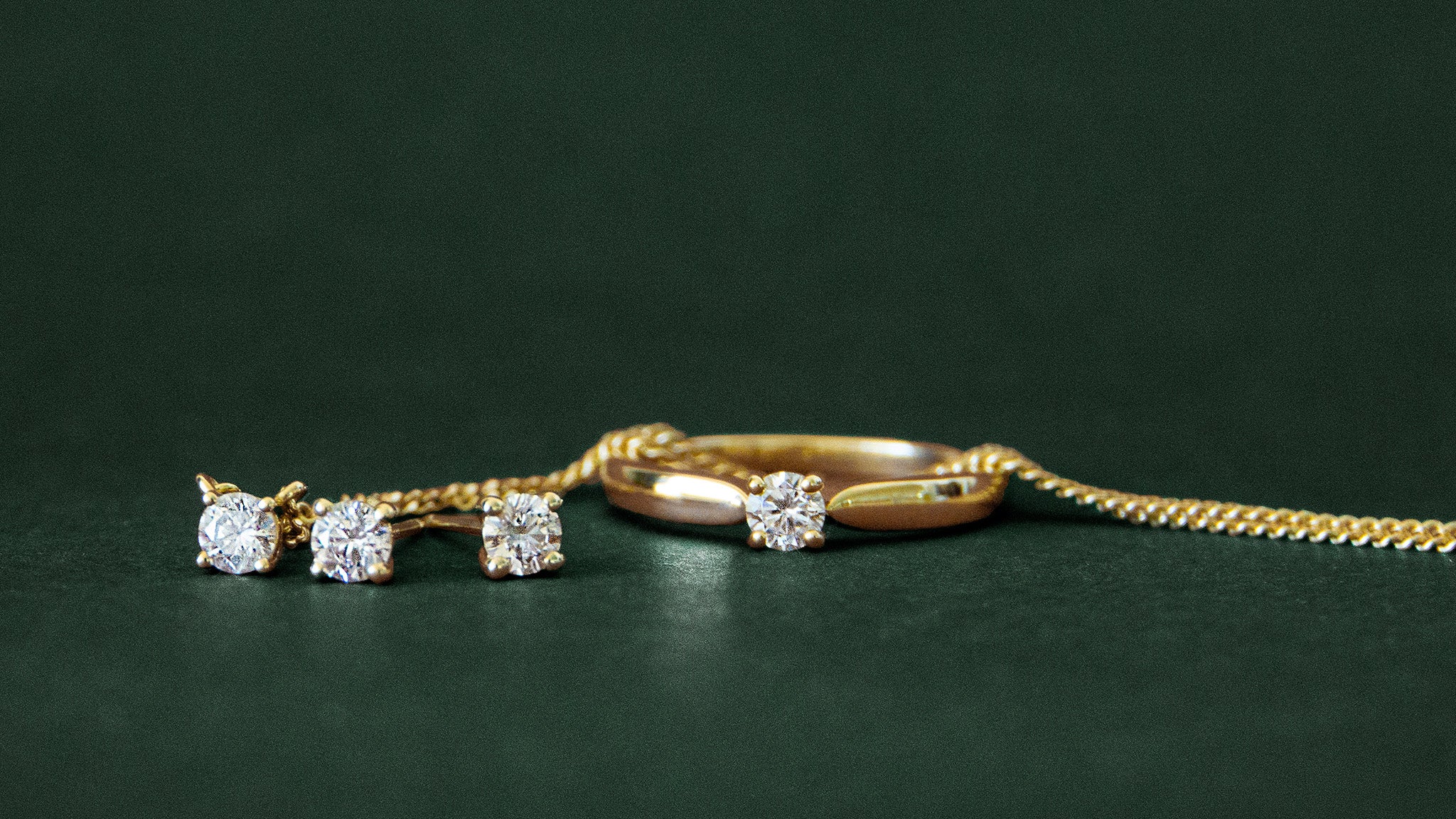What gem is 58x harder than anything else found in nature and is made from just one element?
The Diamond.
Let's take a closer look into the four C's used to measure the quality of this beloved stone.
Carat
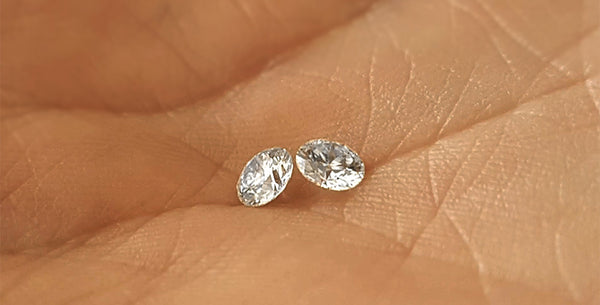
Two quarter-carat brilliant cut diamonds
Cut
Cut in fact does not refer to the shape of the diamond. Surprised? When talking about the cut of diamond, we are talking about the arrangement of its facets and how well they interact with light. This interaction is what controls that diamond brilliance that we all know and love - often described as the most important "C" of the four Cs.
In order to deliver the best transmission of light to create the ultimate sparkle, cutting the rough stone so its facets are precise in proportions, symmetry and high polish are required. When this is achieved, it means the light enters and exits through the same surface, or the table.
Of the four Cs, this is the most complex and technically difficult to analyse. Each cut/facet is analysed on the diamond's "face-up" appearance to determine whether its proportion is delivering the best interaction with light. This creates desirable visual effects of:
- Brightness: The internal and external white light the diamond reflects
- Fire: The scattering of white light into all the colours of the rainbow
- Scintillation: The amount of sparkle a diamond produces and the light and dark patterns caused by reflections within the diamond

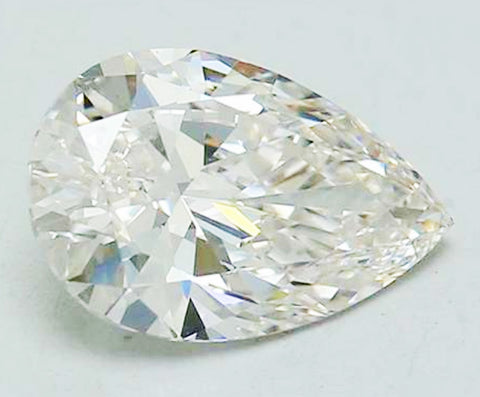
Rough, or raw diamonds need a skilled hand to create a perfectly balanced cut
Colour
In most things, the more colourful or deeper in colour, the higher its quality. With diamonds, we generally find the opposite is true. The less colour a diamond has, or in fact, the absence of colour altogether, the higher in quality; a chemically pure and structurally perfect diamond has no hue.
GIA, the founder of the "Four Cs" and most reputable diamond grading lab in the world has a D to Z diamond colour grading system, with all the letters in between representing slight shade variations from colourless D (often incorrectly referred to as 'white') to deep yellow Z.
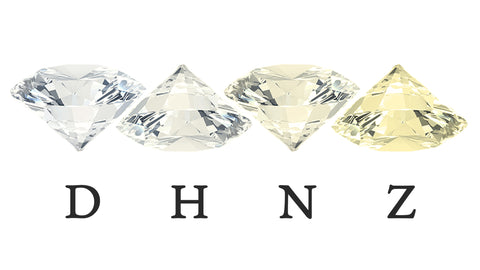
A selection of colour grades from D (colourless) to Z (yellow)
A stone's colour is determined by viewing each one to master stones of an established colour value under controlled lighting and precise viewing conditions. To the average eye, the colour differences between adjacent letter values won't be obvious - but to trained eyes, these subtle differences are very precise and therefore make a large impact on the diamond quality, and ultimately its price.
Of course, other colours of diamonds exist beyond yellow hues. These range from blues and greens through to reds, oranges and pinks, as well as purple, brown and black diamonds. Coloured diamonds are a matter of personal taste and come in and out of fashion. The reason they're less valuable is that their colour is caused by internal impurities or structural defects. It also tends to be true that coloured diamonds by their nature are likely to become dated as trends for different colours change. A colourless diamond goes with everything.
Clarity
The clarity assessment provides a determination based on the number, size, relief and position of inclusions and blemishes (aka birthmarks). Because diamonds are formed under extreme heat and pressure, they will almost always contain either internal flaws ('inclusions') or external flaws ('blemishes').
Contrary to popular belief, these 'birthmarks' occur in both naturally formed and lab created diamonds. Laboratory conditions mimic the conditions deep within the earth, producing the same results. Every diamond is unique.
Under the GIA internationally recognised Diamond Grading System, diamonds are assigned a clarity grade that ranges from flawless (FL) to stones with obvious inclusions (I). Diamonds without any inclusions are rare, and rarity affects a diamond's value.

Source: Gemological Institute of America (GIA)
Under 10x magnification, a grade is assigned to each diamond based on the size, nature, position, colour and quantity of inclusions. Diamond grading is a true skill due to the variety and presentation of different types of inclusions or characteristics in each individual diamond. Most reported diamonds on the market fall between a VS1 and and SI2.
Did you know, most jewellers have never seen a flawless diamond?
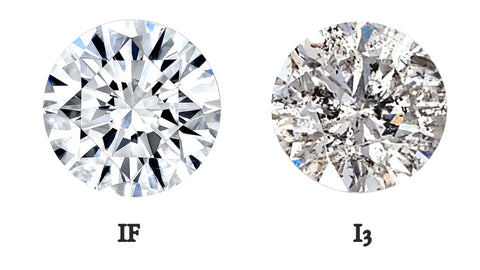
An example of an IF (Internally Flawless) diamond compared with an I3 (Included, grade 3) diamond. Aside from affecting the transparency and brilliance, certain inclusions can make a diamond more susceptible to damage.
On the one hand, it's tempting to disregard anything below the VVS grade in a search for the best diamonds on the market. On the other, how many people do you know carrying around a 10x magnification loupe ready to assess the quality of their friends' new jewellery? This is where 'eye-cleanliness' comes in.
When a diamond is described as 'eye-clean', it means there are no inclusions visible to the naked eye when viewed from the top. Surprisingly to some, practically eye-clean diamonds can be found all the way down to grade SI1, depending on the cut and size of the diamond, and the position of the inclusions. These diamonds can provide amazing value when selecting a larger stone for a custom piece like an engagement ring.
In the end, it's the combination of all four elements of Carat, Cut, Colour, and Clarity that determine each diamond's value. As the customer, only you can determine what 'C' is the most important for your budget and desired outcome.
